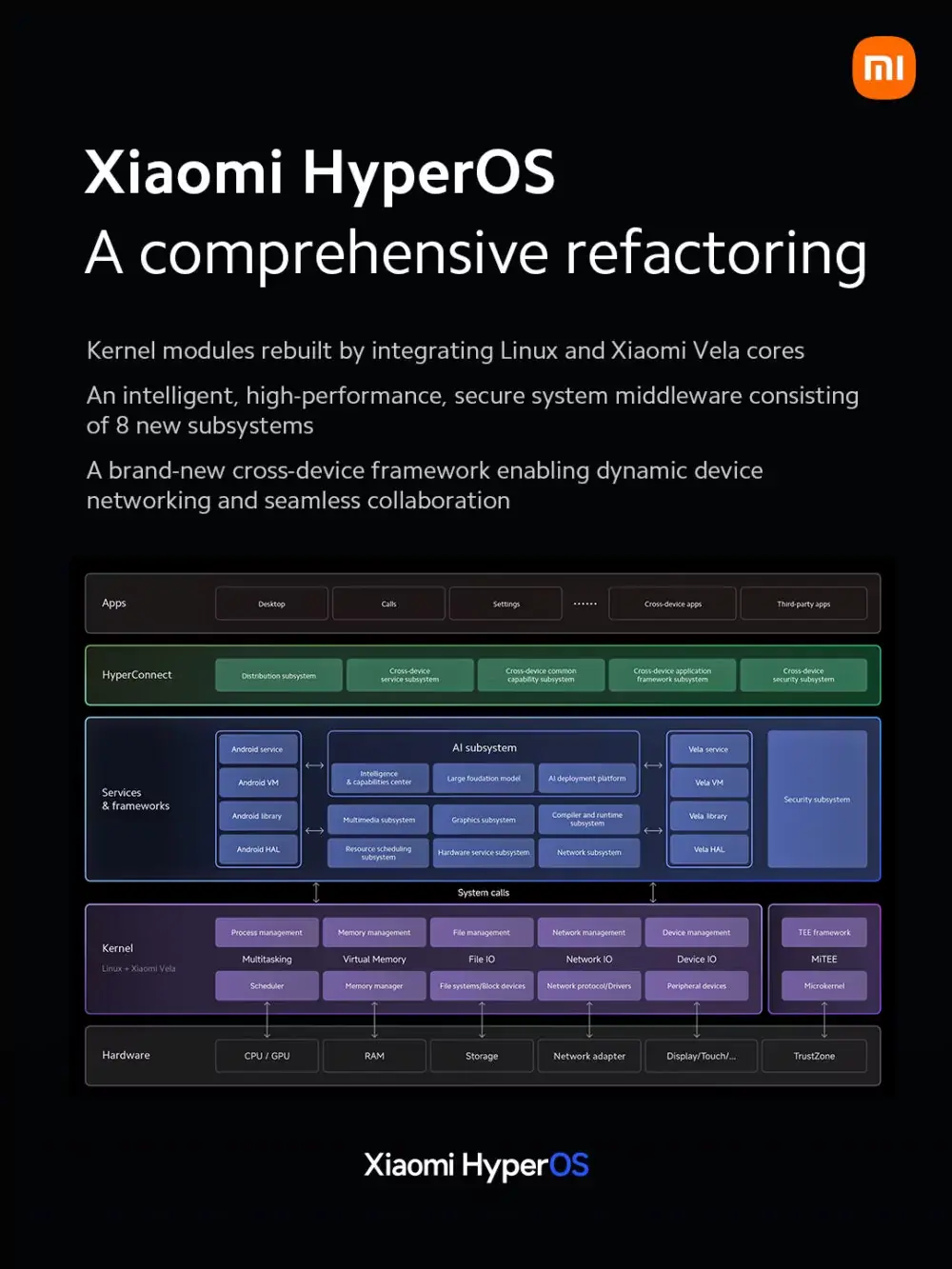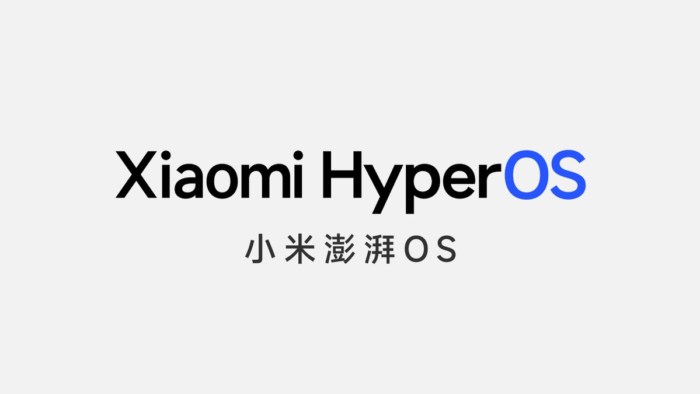Xiaomi, one of the leading tech giants in China, has recently made waves in the tech world with the launch of its latest operating system, HyperOS. This innovative software, unveiled alongside the new Xiaomi 14 and Xiaomi 14 Pro smartphones in China, represents a significant departure from the company’s long-standing MIUI operating system that has been a staple of Xiaomi’s Android devices for the past 13 years. HyperOS, however, is not just a new operating system for Xiaomi smartphones; it’s part of a broader strategy to unify Xiaomi’s entire ecosystem, extending its reach beyond smartphones to include smart home products and even future endeavors like connected cars. This article explores the details of Xiaomi’s HyperOS, its potential impact, and the questions that surround this ambitious venture.
Xiaomi’s New HyperOS: A Revolution or Evolution?

HyperOS: More Than Just a Single Operating System
Xiaomi’s HyperOS is not simply a replacement for MIUI. It is, in fact, a larger and more ambitious endeavor, serving as a unified branding that encompasses Xiaomi’s operating systems across its entire product ecosystem. This expansion goes far beyond smartphones and includes products like the Xiaomi Watch S3, Xiaomi TV S Pro 85-inch MiniLED TV, and other devices that are part of Xiaomi’s growing ecosystem. This strategy hinges on providing a seamless user experience across diverse product categories.
The Duality of HyperOS
At first glance, one might assume that HyperOS is a singular, monolithic operating system designed to run on all Xiaomi devices. However, the reality is more nuanced. Xiaomi’s approach with HyperOS involves different bases for different products. For Internet of Things (IoT) devices, HyperOS relies on the open-source Xiaomi Vela platform, which, in turn, is built upon the open-source RTOS, NuttX. Meanwhile, for smartphones and tablets, HyperOS is based on the Android Open Source Project (AOSP).
One noteworthy aspect is that Android app compatibility is expected to remain robust on Xiaomi smartphones, thanks to the AOSP foundation. The base Android version is also independent of the HyperOS version. For instance, the newly released Xiaomi 14 and Xiaomi 14 Pro ship with HyperOS v1 based on Android 14, while the Xiaomi Pad 5 will be updated to HyperOS v1 based on Android 13. This approach ensures that users will have access to the latest Android features and apps even with Xiaomi’s custom HyperOS.
An Evolution of MIUI
Those familiar with Xiaomi’s MIUI might wonder how different HyperOS really is. From what has been revealed so far, HyperOS on Xiaomi smartphones can be seen as an evolution of the MIUI 14 experience. While there have been changes in the user experience, such as new lockscreen customizations, the fundamental MIUI flavor remains evident in various system apps.
Xiaomi asserts that HyperOS is naturally lightweight, consuming a mere 8.75GB of storage on smartphones. On devices with limited processing power, HyperOS boasts scheduling changes aimed at maximizing hardware performance. Furthermore, the company claims that HyperOS provides a stable frame rate and lower power consumption when compared to stock Android, particularly during gaming sessions.

The Technical Reengineering of HyperOS
Xiaomi claims to have undertaken extensive restructuring of technical modules within HyperOS. It includes the file system, memory management, imaging subsystem, and network system. However, the technical specifics that differentiate HyperOS from AOSP and MIUI remain somewhat elusive. While the company hints at these changes, it has yet to offer a comprehensive technical breakdown of these improvements.
HyperConnect: For a Unified Ecosystem Experience
One area where Xiaomi’s HyperOS shows promise is the introduction of the HyperConnect framework. It will be a key feature across all devices within the Xiaomi ecosystem. Through HyperConnect, Xiaomi aims to seamlessly interconnect its devices, fostering a cohesive ecosystem experience. The implications of HyperConnect are intriguing, as it might redefine how Xiaomi users interact with their gadgets. The challenge, however, is how Xiaomi’s HyperConnect will coexist with other initiatives, such as Qualcomm’s Snapdragon Seamless.
AI and Xiaomi’s HyperOS
Xiaomi promises AI-powered use cases and improvements within its HyperOS, though the message is somewhat muddled. It’s not entirely clear how AI will be available in the broader ecosystem, especially considering Xiaomi’s diverse range of products. However, it seems that AI functions will be part of the AOSP-based HyperOS on smartphones. One example is the HyperOS Gallery app. It will gain generative AI capabilities to enhance and expand existing images.
The Global Rollout of HyperOS
Xiaomi’s CEO, Mr. Lei Jun, has confirmed that the international rollout of Xiaomi HyperOS is scheduled to begin in the first quarter of 2024. However, the company has yet to specify which products will receive the first HyperOS updates on a global scale. This rollout is highly anticipated, as it will provide a clearer picture of Xiaomi’s vision for HyperOS beyond its home market.
HyperOS: Room for Improvement
Despite the excitement surrounding Xiaomi’s HyperOS, some concerns and ambiguities persist. Xiaomi’s approach to branding HyperOS as a single entity for all its products. Including smartphones and IoT devices, can be somewhat perplexing. Many argue that a clearer classification, such as “HyperOS IoT” and “HyperOS Mobile,” would make the user experience and marketing communication more straightforward.
Moreover, it remains unclear whether HyperOS for mobile devices will address some of the issues that users have faced with MIUI, such as slow updates and aggressive battery optimizations. It’s also uncertain whether all the standard Android platform changes, like those found in Android 14, will seamlessly transition to HyperOS. These questions and concerns highlight the importance of the stable global rollout in 2024. It will offer a more comprehensive view of the HyperOS experience.
In conclusion, Xiaomi’s HyperOS is an ambitious endeavor that seeks to unify its entire product ecosystem under a single operating system. While the concept is intriguing, there are concerns and questions regarding its execution and the user experience it will provide. As the international rollout approaches, tech enthusiasts and Xiaomi users around the world eagerly await the opportunity to explore the full potential of Xiaomi’s HyperOS and see how it fits into their daily lives.

Some other thoughts on Xiaomi HyperOS:
- HyperOS could be a major force in the IoT market. With its support for a wide range of devices, HyperOS could become the go-to operating system for smart homes and other IoT applications.
- HyperOS could help Xiaomi to differentiate itself from its competitors. In a crowded smartphone market, HyperOS could give Xiaomi a unique selling point.
- HyperOS could be a boon for developers. With a single unified ecosystem, developers will be able to create apps that work seamlessly across all Xiaomi devices.
However, there are also some potential risks associated with HyperOS:
- HyperOS could be too complex. With so many different devices and features to support, HyperOS could become difficult to manage and update.
- HyperOS could alienate existing MIUI users. If Xiaomi is not careful, the transition to HyperOS could be disruptive for existing MIUI users.
- HyperOS could be vulnerable to security attacks. With so many different devices connected to the same ecosystem, HyperOS could be a prime target for hackers.





